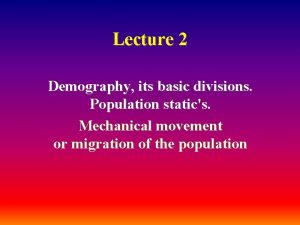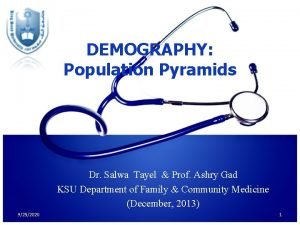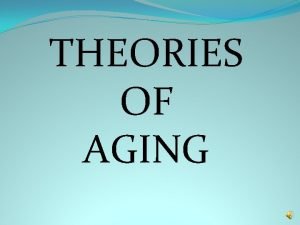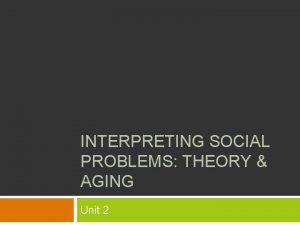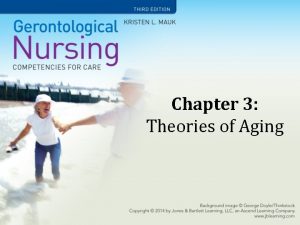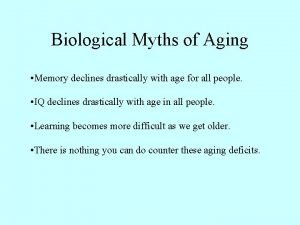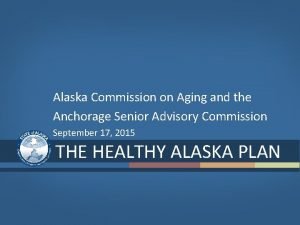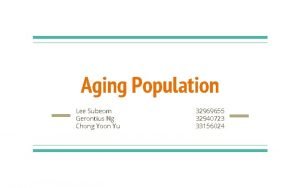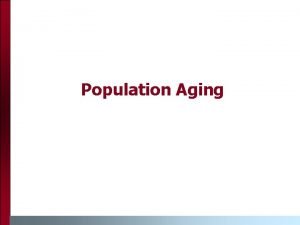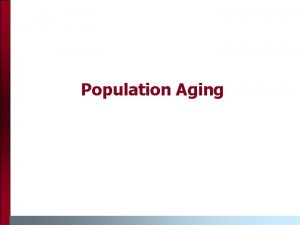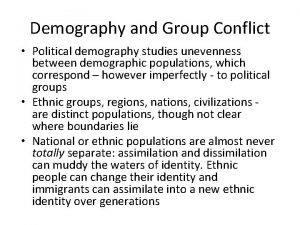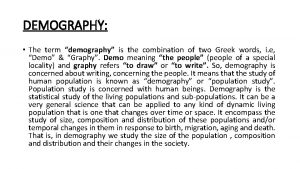Demography of Aging Chapter 2 Demography The statistical



















- Slides: 19

Demography of Aging Chapter 2

Demography The statistical study of human populations especially with reference to: Size & Density distribution Vital statistics (epidemiology: births, deaths, diseases)

Percent Surviving Survival Curves for U. S. Population, 1900 to 2002 100 2002 80 1950 1900 60 40 20 0 0 10 20 30 40 50 60 70 80 90 100 Age Source: Arias E. United States Life Tables, 2002. National Vital Statistics Reports; vol. 53, no. 6. Hyattsville, MD: National Center for Health Statistics, 2004.

Probability of 50 year old living to 90, 1900 to 2002 30 26. 6 25 Percent 20 15. 2 15 5 0 Women 9. 6 10 2. 7 3. 8 1900 Men 5. 0 1950 2002 Source: Computed from U. S. life tables in: Arias E. United States life tables, 2002. National vital statistics reports; vol. 53, no. 6. Hyattsville, MD: National Center for health Statistics, 2004.

Figure 2. 1: Life expectancy at birth by sex, France 1806 -1997

Increase in Average Life Expectancy in Years in Some Countries, 1950 -1995, Total (MF) Developed Countries Developing Countries Japan 15 China 30 Italy 11 Turkey 24 France 10 India 22 United Kingdom 7 Egypt 19 USA 7 Kenya 18 Sweden 6. 1 Brazil 15 Argentina 9

Life expectancy and infant mortality throughout human history Life expectancy Infant mortality rate at birth (years) (per 1000 live births) Prehistoric 20 -35 200 -300 Sweden, 1750 s 37 210 India, 1880 s 25 230 U. S. , 1900 48 133 France, 1950 66 52 Japan, 1996 80 4


Proportion of population aged 0 -14 versus 65+(In Italy)


Figure 2. 5: Maximum life span in Sweden

Annual number of females reaching 100 years in the North European countries Number of centenarians per million inhabitants in Denmark (1800 -1994)

Centenarians: USA 1990: Harvard University started New England Centenarian Study (JAMA 288: 18 p. 2247, 2002). Data from this study refute the idea that aging represents an inexorable march…characterized by a steady decline. Rather, centenarians are generally in very good health. They are either: - Escapers “People who have escaped any disease” - Late onset of disease, 85+ - Early onset of disease which was overcome JAPAN 2004: Reports identify - SSC (Semi-Super Centenarians), age 105+ years. - SC (Super Centenarians), 110+ years In both groups, alterations in the gene coding for I / IGF-1 receptor

Dr. John Wilmoth Christian Mortensen 1882 -1998


Average Lifespan at Birth for Females, 1990 -1995 and Lifespan Differential in Years Developed Countries F-M Japan 82 6 Sweden 81 6 Italy 80 6 France 81 8 United Kingdom 77 5 USA 80 7 USSR (previous) 75 10 Developing Countries Argentina 75 China 73 Turkey 70 Brazil 69 Egypt 63 India 61 Kenya 61 7 3 5 6 2 1 4

Probable causes for longevity in favor of women: • Genetic (XX vs. XY) or Environmental (geography, country, income) • Other causes: Lesser life stress in females Less smoking Protective action of estrogens? Lesser accumulation of m. DNA deletions/mutations with better protection against oxidative damage Others? Implication for prevention and treatment

Older women whose parents survived past age 90 are generally healthier than women whose parents did not survive as long. These women … • • • overall death rates die of cardiovascular disease report a diagnosis of diabetes mental and mobility limitaions risk of hip fracture and non-spine fractures* • have higher self-rated quality of life • have faster walking speed and better measures of grip strength *reduced fracture risk seen for maternal, but not paternal survival past age 90 Data from the Study of Osteoporotic Fractures (SOF), Peggy Cawthon

Survival of Female Offspring (65+ years) from Cardiovascular Disease Death based on Maternal Longevity 100 % Survival 95 90 HR=0. 78, p=0. 001 85 80 Mother died before age 90 Mother survived past age 90 0 2 4 6 8 10 12 14 16 Follow-up time from study entry (years) Women whose mothers survived past age 90 had an approximately 20% lower risk of cardiovascular disease death compared to women whose mothers did not live as long Data from the Study of Osteoporotic Fractures (SOF), Peggy Cawthon
 Static demography
Static demography Cso business demography
Cso business demography Elements of demography
Elements of demography Demographic transition model ap human geography definition
Demographic transition model ap human geography definition Population demography definition
Population demography definition Sources of demography ppt
Sources of demography ppt Components of demography
Components of demography Slash and burn agriculture antonym
Slash and burn agriculture antonym Chapter 10:4 confusion and disorientation in the elderly
Chapter 10:4 confusion and disorientation in the elderly Garontology
Garontology Philosophy for old age
Philosophy for old age What market form of meat does not undergo chilling
What market form of meat does not undergo chilling Problems with conflict theory
Problems with conflict theory Aging algorithm page replacement
Aging algorithm page replacement Non stochastic theory of aging
Non stochastic theory of aging Conclusion of aging
Conclusion of aging Dr berg anti aging
Dr berg anti aging Alaska commission on aging
Alaska commission on aging Subeom
Subeom Aging aircraft solutions
Aging aircraft solutions
